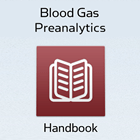Printed from acutecaretesting.org
April 2006
Red-cell transfusion – risks and benefits - part 2 of 2
All tissue cells require a continuous supply of oxygen for optimal function, and cell death (necrosis), organ dysfunction and organ failure soon follow if sufficient oxygen supply is interrupted.
Our only source of oxygen is that present in inspired air and delivered from the lungs to tissue cells in blood.
The vital oxygen-delivery function of blood is executed by red cells, or to be more precise the hemoglobin contained within them, and reduction in red-cell mass, i.e. anemia, jeopardizes the supply of oxygen to tissue cells.
The clinical utility of red-cell transfusion is limited to the rapid [1] restoration of adequate oxygenation of tissues in those who are anemic.
However, although all patients who are given a red-cell transfusion are anemic, only a small proportion of anemic patients require transfusion.
In other words, anemia is a necessary, but not sufficient reason for red-cell transfusion.
A major consideration for possible prescription of red cells is the severity of the anemia, but there are other factors.
Before discussion of these issues, it would be useful to quickly review anemia, its causes and symptoms, as well as the physiological compensatory mechanisms that serve to protect the anemic patient from tissue hypoxia and the need for red-cell transfusion.
ANEMIA - DEFINITION AND CAUSES
Anemia (literally, without blood) is defined as a decrease in red-cell mass and therefore the amount of hemoglobin in blood.
The diagnosis is usually made by measurement of the blood concentration of hemoglobin (ctHb); anemia is established if ctHb is below the lower limit of the reference range, i.e. less than 13.5 g/dL (8.4 mmol/L) for adult males and less than 11.5 g/dL (7.1 mmol/L) for adult females.
In children, who normally have slightly lower ctHb, a diagnosis of anemia is made if ctHb is less than 11.0 g/dL (6.8 mmol/L).
There is only one situation in which anemia is associated with normal ctHb; that is in the immediate aftermath of acute blood loss.
During acute blood loss (hemorrhage), red cells and plasma are lost in equal measure, so that the concentration of hemoglobin (ctHb), i.e. the amount of hemoglobin per unit volume of plasma, remains unchanged despite absolute reduction in the number of red cells and the hemoglobin they contain.
Thus immediately after hemorrhage, ctHb may remain normal despite anemia (reduction in red-cell mass).
The physiological response to the hypovolemia induced by hemorrhage is movement of water from the extravascular to the intravascular space; as plasma volume expands, ctHb falls, and the full extent of hemorrhage-induced anemia is revealed.
Anemia may be caused by
- Acute blood loss (hemorrhage) due to trauma, surgery, coagulation defects, etc.
- Nutritional or functional deficiency of substances required for red-cell production (e.g. iron, Vitamin B12, folate)
- Anemia of chronic disease – malignancy, chronic inflammatory or infectious disease
- Renal failure – inadequate erythropoietin production
- Increased red-cell destruction – the hemolytic anemias
- Bone-marrow-stem failure (aplastic anemia) due to cytotoxic or radiation therapy
- Hematological malignancy (myeloma, leukemia, etc.)
A distinction is made between acute and chronic anemia. Acute anemia is that associated with a sudden precipitous fall in red-cell numbers due to hemorrhage or, much more rarely, a severe acute hemolytic episode.
By contrast, in all other cases of anemia the reduction in red-cell numbers is gradual – this is chronic anemia.
The distinction is important because chronic anemia is associated with important compensatory changes, some of which are simply not possible in the short time frame of acute anemia.
ANEMIA - COMPENSATORY CHANGES
The real threat to the anemic patient is tissue hypoxia consequent on the reduced oxygen-carrying capacity of blood.
Within limits, the body has the capacity to compensate for the reduced oxygen in blood associated with anemia and maintain adequate oxygenation of tissues.
For example, anemia is associated with increased production of 2,3-diphosphoglycerate and consequent shift in the oxygen dissociation curve to the right. This shift reflects decreased hemoglobin affinity for oxygen.
Hemoglobin more readily gives oxygen up to the tissues – oxygen delivery to the tissues is thus enhanced by anemia.
There is some redistribution of blood flow from areas (such as skin and kidneys) to ensure enhanced perfusion and thereby improved oxygenation of vital areas such as the brain and heart.
Other mechanisms that help maintain adequate tissue oxygenation in the anemic patient include decreased blood viscosity and peripheral vasodilatation.
Finally, oxygen delivery to tissues is a function not only of the oxygen in blood but also of cardiac output.
Severe anemia induces increased heart rate and stroke volume which together result in increased cardiac output and consequent increase in oxygen delivery to tissues.
ANEMIA - SYMPTOMS
So long as compensatory mechanisms continue to ensure normal oxygenation of tissues, anemia is essentially a subclinical disease that would only normally be identified if ctHb were measured.
However, if anemia is sufficiently severe, and/or the demand for oxygen increased by comorbidity or physical activity, compensatory mechanisms are overwhelmed and anemia becomes clinically apparent.
Generalized symptoms of anemia, irrespective of cause, reflect both compensatory mechanisms and relative tissue hypoxia.
They include:
- Pallor
- Tiredness and lethargy
- Shortness of breath, particularly on exertion
- Dizziness, fainting
- Headache, loss of mental acuity
- Increased heart rate (tachycardia), palpitations
- Increased respiratory rate (tachypnea)
- Exacerbation of anginal symptoms (ischemic chest pain) among those with coronary heart disease.
- Vague undefined feeling of not being well
PRINCIPLES INVOLVED IN CLINICAL DECISION TO PRESCRIBE RED CELLS
The justification for administering red cells is the clinical need to rapidly raise the oxygen-carrying capacity of blood of anemic patients in order to prevent the damaging effects of tissue hypoxia that threatens all organ systems.
The factors that are considered in determining the need for transfusion include:
- Severity of anemia (ctHb)
- Severity of anemia (symptoms)
- Acute or chronic
- Etiology of chronic anemia
- Comorbidity
- Risk of blood loss
Severity of anemia (ctHb)
Severity of anemia, measured as ctHb, has always been a very significant determinant of the need for red-cell transfusion.
The concept of transfusion trigger was born out of the very appealing but long since discredited notion that it is possible to identify a concentration of hemoglobin that defines the need for red-cell transfusion for all patients.
For many decades, a ctHb of 10 g/dL (6.8 mmol/L) was widely accepted as a trigger for blood transfusion, particularly among surgical and ICU patients, but the evidence base for such a trigger was always thin [2] and recent research outlined below suggests that the trigger is too high.
In the absence of a sufficiently strong evidence base, controversy currently surrounds the use of ctHb transfusion triggers.
There is, however, a necessarily pragmatic consensus that nearly all patients with ctHb less than 6 g/dL (3.7 mmol/L) will benefit from red cells, nearly all patients with ctHb of 10 g/dL (6.8 mmol/L) or greater will not benefit from red cells, and the decision to transfuse those whose ctHb is between 6 and 10 g/dL (3.7-6.8 mmol/L) should be based on consideration of other factors [3, 4].
Authorities emphasize that it is not best practice to consider ctHb in isolation when deciding if red-cell transfusion is warranted
Severity of anemia (symptoms)
One of the reasons why there is no reliable universal ctHb trigger for red-cell transfusion is that the ability to compensate for reduced ctHb and thereby avoid symptoms of anemia varies according to age, level of activity and presence of comorbidities such as cardiovascular or respiratory disease.
Thus an otherwise healthy child may tolerate ctHb as low as 5 g/dL (3.1 mmol/L) and be symptom free [5], but an elderly person with coronary heart disease may have quite debilitating anginal symptoms of anemia with a ctHb as high as 9 g/dL (5.6 mmol/L).
The elderly person is, paradoxically, the more likely of the two to benefit from red-cell transfusion.
Relief of the symptoms (tiredness, breathlessness, etc.) associated with chronic anemia is a major benefit of red-cell transfusion.
Acute or chronic
In general, for a given reduction in red-cell mass chronic anemia is less likely to be associated with severe symptoms and the need for red-cell transfusion than is acute anemia because of the more effective compensation among those whose anemia is long standing.
Etiology of chronic anemia
There are alternative specific treatments for many types of anemia (e.g. iron supplements for iron deficiency anemia, Vitamin B12 for megaloblastic anemia, erythropoietin for anemia associated with renal failure, etc.).
Red cells are contraindicated if there is an alternative treatment unless there is an urgent need to restore minimal red-cell mass, i.e. the anemia is so severe that life is threatened.
Comorbidity
Those with cardiovascular disease (particularly those with unstable coronary heart disease) and respiratory disease are more vulnerable than healthy individuals to the relative tissue hypoxic effect of anemia.
The transfusion trigger may well be set at a higher ctHb for these more vulnerable patients.
Risk of blood loss
The risk of occult blood loss is an important consideration for assessment of the need for red-cell transfusion to the anemic trauma victim, and assessment of the likely blood loss during surgery will guide the use of red cells among anemic surgical patients.
Assessment in both cases will take account of comorbidities (and drugs) associated with decreased blood coaguability and resulting increased tendency to bleed.
CLINICAL STUDIES EXAMINING THE EFFICACY OF RED-CELL TRANSFUSION
Over the past decade or so, there has been huge economic and research investment to ensure the safety of the donated blood supply. Research has also provided a clear understanding of both the nature and magnitude of the risks associated with red-cell transfusion.
There is, by contrast, a paucity of knowledge about the benefit of red-cell transfusion.
It is remarkable that despite the routine use of blood transfusion for over 50 years, now involving the transfusion of 12 million red-cell units every year in the US alone, only 12 randomized clinical trials of red-cell transfusion have ever been conducted.
There is not sufficient evidence at the present time to provide a consensual answer to the important question: does red-cell transfusion do what it is intended to do – improve outcome or prevent adverse outcomes?
Arguably, it is only in the last decade that the question has even been considered.
The Transfusion Requirements in Critical Care (TRICC) study
One of the most influential studies in this area comes from the Canadian Clinical Care Trials Group, which was formed in 1989 with the general aim of improving the care of critically ill patients through clinical research.
The use of transfused red cells is just one of many aspects of critical care they have addressed. In 1999, the group published what remains the largest clinical trial of red-cell transfusion [7].
Prior to the study, conventional clinical practice relating to red-cell prescribing for critically ill patients was widely based on the so-called "10/30" transfusion trigger.
Red cells were prescribed if ctHb dropped below 10 g/dL (6.8 mmol/L) or hematocrit (PCV) dropped below 30 %.
The group designed a prospective clinical trial to test their hypothesis that a more restrictive red-cell transfusion policy is no less effective than that required to comply with the 10/30 rule.
Eight hundred and thirty-eight critically ill patients, all with an admission ctHb < 9.0 g/dL (5.6 mmol/L) were randomly assigned to one of two treatment groups. The transfusion trigger for the first group was 10 g/dL (6.8 mmol/L), the aim being to maintain ctHb between 10-12 g/dL (6.8-7.5 mmol/L).
The transfusion trigger for the second group was 7 g/dL (4.3 mmol/L) with the aim of maintaining ctHb between 7.0 and 9.0 g/dL (4.3-5.6 mmol/L).
On average, those in the liberally (conventional) transfused group received 5.6 packed-red-blood-cells (PRBC) units each and those in the restrictive group received only 2.6 PRBC units each.
Around a third of the patients in the restrictive group maintained their target ctHb (between 7 and 9 g/dL (4.3-5.6 mmol/L)) without the need for any red cells.
Outcome measures included 30- and 60-day mortality, days to discharge from intensive care and days to discharge from hospital.
All these outcome measures indicated that "the restrictive red cell transfusion strategy was at least as effective and possibly superior to the liberal transfusion strategy".
This study demonstrated that anemic, critically ill patients can tolerate a much lower ctHb than was previously supposed. Many patients given red cells gain no benefit and the study provided some evidence to suggest that for some undefined patient groups, the red cells they were given did more harm than good.
This study was instrumental in changing transfusion practice in intensive care units [8].
Poor outcome for transfused trauma victims
The TRICC study looked specifically at the critically ill, but there have been seven other studies that have compared outcome for patients of either a liberal or restrictive transfusion policy in a range of clinical contexts, including orthopedic surgery, cardiac revascularization and gastrointestinal hemorrhage.
A recent meta-analysis [9] of all these studies concluded that restrictive policy is associated with either no difference in outcome or more favorable outcome.
The implied suggestion that red-cell transfusion may be harmful for some patients is echoed in the results of several studies that have focused on trauma victims.
The authors of one study [10] retrospectively reviewed the case notes of 316 trauma victims who had all sustained the same kind of blunt injury to liver and spleen, predominantly during motor-vehicle accidents.
Around half (45 %) of these patients were given red-cell transfusion. The investigators found that red-cell transfusion was an independent risk factor for death in this cohort. The relationship was dose dependent.
After controlling for injury severity and clinical condition, those who received red cells were found to be 4.75 times more likely to die than those who were not given red cells.
Among survivors, those who were given transfusion required significantly longer hospital stay (mean 19 days) than those who were not given transfusion (mean 11 days).
Of many variables tested, transfusion emerged as the only independent predictor of length of hospital stay.
Another study [11] of 7,602 trauma victims found that blood transfusion was an independent predictor of mortality, systemic inflammatory response syndrome (SIRS) and length of stay in intensive care.
Immunologic and inflammatory effect of red-cell transfusion
The counterintuitive notion that red-cell transfusion might contribute to the death of intensive care patients is consistent with the evidence of these and other studies and one that some expert are willing to entertain [10], although the mechanism of this putative toxicity remains far from clear.
Since multiple organ failure consequent on sepsis is a major cause of intensive care mortality, some have speculated that it might operate through the adverse effects on the immune system that are associated with red-cell transfusion [12].
Others consider that the functional changes in red cells during storage might be significant [13].
SUMMARY
Blood transfusion was introduced to clinical care more than 60 years ago, long before the randomized placebo-controlled trial was first used to validate new treatments.
For the best part of those 60 years, the beneficial value of blood-group compatible, viral-free donated blood was assumed without challenge.
Recent research now suggests that for some poorly defined patient groups red-cell transfusion may be not only ineffective but actually harmful.
More research measuring outcome following transfusion is needed so that we can better define those patient groups who gain benefit from transfusion and can justifiably be exposed to the associated risks.
References+ View more
- Elizalde J, Clemente J et al. Early changes in hemoglobin and hematocrit levels after packed red cell transfusion in patients with acute anemia. Transfusion 1997; 37: 573-76
- Speiss B. Risks of transfusion: outcome focus. Transfusion 2004; 44: 4S-14S
- Anon. Practice guidelines for blood component therapy: a report by the American Society of Anesthesiologists Task Force on Blood Component Therapy. Anesthesiology 1996; 84(3): 732-47
- British Society for Standards in Haematology. Blood Transfusion Workforce Guidelines for the Clinical Use of Red Cell Transfusions. Br J Haem 2001; 113: 24-31
- Haberkeen M, Dangel P. Normovolemic hemodilution and intraoperative autotransfusion in children: experience of 30 cases of spinal fusion. Eur J Pediatr Surgery 1991; 1: 30-35
- Hardy J-F. Current status of transfusion triggers for red blood cell concentrates. Transfus Apheresis Sci 2004; 31: 55-66
- Herbert P, Wells G et al. A multicenter, randomized clinical trial of transfusion requirements in critical care. New Eng J Med 1999; 340: 409-17
- Herbert P, Fergusson D et al. Revisiting transfusion practices in critically ill patients. Critical Care Medicine 2005;
- Carson J, L Hill S et al. Transfusion triggers: a systematic review of the literature. Transfus Med Rev 2002; 16: 187-99
- Robinson W, Ahn J et al. Blood transfusion is an independent predictor of increased mortality in non-operatively managed blunt hepatic and splenic injuries. J Trauma 2005; 58: 37-445
- Dunn JR, Malone DL et al. Allogenic blood transfusion in the first 24 hours after trauma is associated with increased systemic inflammatory response syndrome (SIRS) and death. Surgical Infection 2004; 5: 396-404
- Brand A. Immunological aspects of blood transfusions. Transp Immunol 2002; 10: 183-90
- Marik P, Sibbald W. Effect of stored-blood transfusion on oxygen delivery in patients with sepsis. JAMA 1993; 269: 3204-29
References
- Elizalde J, Clemente J et al. Early changes in hemoglobin and hematocrit levels after packed red cell transfusion in patients with acute anemia. Transfusion 1997; 37: 573-76
- Speiss B. Risks of transfusion: outcome focus. Transfusion 2004; 44: 4S-14S
- Anon. Practice guidelines for blood component therapy: a report by the American Society of Anesthesiologists Task Force on Blood Component Therapy. Anesthesiology 1996; 84(3): 732-47
- British Society for Standards in Haematology. Blood Transfusion Workforce Guidelines for the Clinical Use of Red Cell Transfusions. Br J Haem 2001; 113: 24-31
- Haberkeen M, Dangel P. Normovolemic hemodilution and intraoperative autotransfusion in children: experience of 30 cases of spinal fusion. Eur J Pediatr Surgery 1991; 1: 30-35
- Hardy J-F. Current status of transfusion triggers for red blood cell concentrates. Transfus Apheresis Sci 2004; 31: 55-66
- Herbert P, Wells G et al. A multicenter, randomized clinical trial of transfusion requirements in critical care. New Eng J Med 1999; 340: 409-17
- Herbert P, Fergusson D et al. Revisiting transfusion practices in critically ill patients. Critical Care Medicine 2005;
- Carson J, L Hill S et al. Transfusion triggers: a systematic review of the literature. Transfus Med Rev 2002; 16: 187-99
- Robinson W, Ahn J et al. Blood transfusion is an independent predictor of increased mortality in non-operatively managed blunt hepatic and splenic injuries. J Trauma 2005; 58: 37-445
- Dunn JR, Malone DL et al. Allogenic blood transfusion in the first 24 hours after trauma is associated with increased systemic inflammatory response syndrome (SIRS) and death. Surgical Infection 2004; 5: 396-404
- Brand A. Immunological aspects of blood transfusions. Transp Immunol 2002; 10: 183-90
- Marik P, Sibbald W. Effect of stored-blood transfusion on oxygen delivery in patients with sepsis. JAMA 1993; 269: 3204-29
May contain information that is not supported by performance and intended use claims of Radiometer's products. See also Legal info.
Acute care testing handbook
Get the acute care testing handbook
Your practical guide to critical parameters in acute care testing.
Download nowRelated webinar
Evolution of blood gas testing Part 1
Presented by Ellis Jacobs, PhD, Assoc. Professor of Pathology, NYU School of Medicine.
Watch the webinar









